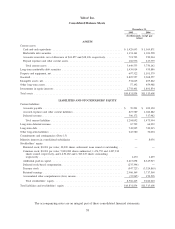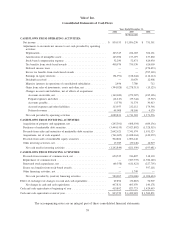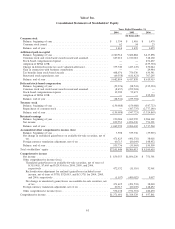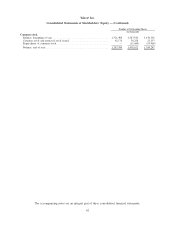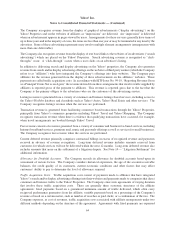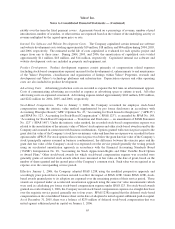Yahoo 2006 Annual Report Download - page 78
Download and view the complete annual report
Please find page 78 of the 2006 Yahoo annual report below. You can navigate through the pages in the report by either clicking on the pages listed below, or by using the keyword search tool below to find specific information within the annual report.stockholders’ equity. The Company recorded foreign currency transaction gains and losses, realized and unrealized
in other income, net on the consolidated statements of income, of approximately $6 million of net gains in 2004, net
losses of $8 million in 2005, and net gains of $5 million in 2006.
Recent Accounting Pronouncements
In June 2006, the Financial Accounting Standards Board (“FASB”) issued FASB Interpretation No. 48, “Account-
ing for Uncertainty in Income Taxes — an Interpretation of FASB Statement No. 109” (“FIN 48”), which clarifies
the accounting for uncertainty in income tax positions. This Interpretation requires that the Company recognize in
its financial statements the impact of a tax position if that position is more likely than not of being sustained on
audit, based on the technical merits of the position. The provisions of FIN 48 became effective for the Company on
January 1, 2007, with the cumulative effect of the change in accounting principle, if any, recorded as an adjustment
to opening retained earnings. The Company is currently evaluating the impact of adopting FIN 48 and its impact on
its financial position, cash flows, and results of operations.
In September 2006, the Securities and Exchange Commission (“SEC”) released SAB No. 108, “Considering the
Effects of Prior Year Misstatements when Quantifying Misstatements in Current Year Financial Statements”
(“SAB 108”). SAB 108 provides interpretive guidance on the SEC’s views on how the effects of the carryover or
reversal of prior year misstatements should be considered in quantifying a current year misstatement. The
Company adopted SAB 108 during the fourth quarter of 2006. The adoption did not have a material impact on the
Company’s financial position, cash flows, or results of operations.
In September 2006, the FASB issued SFAS No. 157, “Fair Value Measurements” (“SFAS 157”), which clarifies the
definition of fair value, establishes guidelines for measuring fair value, and expands disclosures regarding fair value
measurements. SFAS 157 does not require any new fair value measurements and eliminates inconsistencies in
guidance found in various prior accounting pronouncements. SFAS 157 will be effective for the Company on
January 1, 2008. The Company is currently evaluating the impact of adopting SFAS 157 but does not believe that the
adoption of SFAS 157 will have a material impact on its financial position, cash flows, or results of operations.
In February 2007, the FASB issued SFAS No. 159, “The Fair Value Option for Financial Assets and Financial
Liabilities” (“SFAS 159”) which permits entities to choose to measure many financial instruments and certain other
items at fair value that are not currently required to be measured at fair value. SFAS 159 will be effective for the
Company on January 1, 2008. The Company is currently evaluating the impact of adopting SFAS 159 on its
financial position, cash flows, and results of operations.
Note 2 BASIC AND DILUTED NET INCOME PER SHARE
Basic net income per share is computed using the weighted average number of common shares outstanding during
the period, excluding any unvested restricted stock that is subject to repurchase. Diluted net income per share is
computed using the weighted average number of common shares and, if dilutive, potential common shares
outstanding during the period. Potential common shares consist of unvested restricted stock and restricted stock
units, collectively referred to as “restricted stock awards” (using the treasury stock method), the incremental
common shares issuable upon the exercise of stock options (using the treasury stock method) and the conversion of
the Company’s zero coupon senior convertible notes (using the if-converted method). For 2004, 2005, and 2006,
approximately 50 million, 55 million, and 108 million options to purchase common stock, respectively, were
excluded from the calculation, as the exercise prices were greater than the average market price of the common
stock during the respective years. See Note 9 — “Long-Term Debt” for additional information related to the
Company’s zero coupon senior convertible notes.
68
Yahoo! Inc.
Notes to Consolidated Financial Statements — (Continued)


